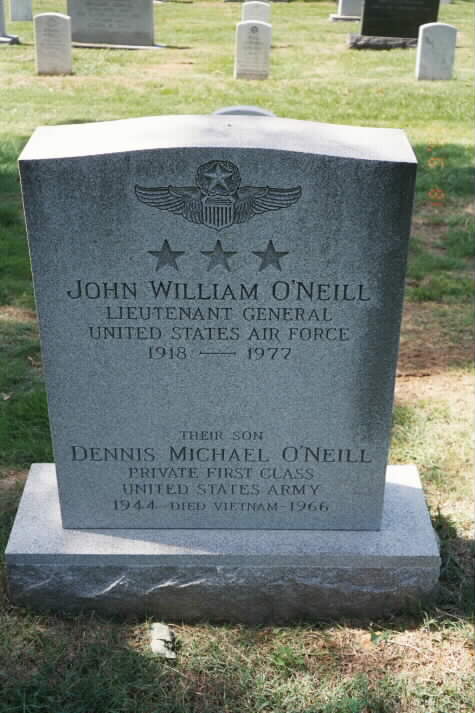Courtesy of the United States Air Force:
LIEUTENANT GENERAL JOHN W. O’NEILL
Retired September 1, 1972, Died March 24, 1977
Lieutenant General John William O’Neill was vice commander of the Air Force Systems Command, Andrews Air Force Base, Maryland. AFSC is responsible for the advancement of aerospace technology, its adaptation to operational aerospace systems, and aerospace vehicles and materiel required for the accomplishment of the
Air Force mission.
General O’Neill was born in Brookline, Massachusetts. He graduated from Brookline High School in 1936 and from Boston University in 1940. He completed Reserve Officers Training Corps at Boston University and was appointed a second lieutenant in the Officers Reserve Corps. He entered active military duty in July 1940 and
was appointed to the Regular Army one year later.
His first assignment was to the Base Quartermaster Office at Fort Devens, Mass. Later he served with the First Infantry Division in Massachusetts and Florida.
In 1942 he completed Advanced Flying School, received his pilot wings at Marianna, Fla., and was assigned as an instructor in B-17 aircraft. In 1944 he was assigned to a B-29 aircraft combat crew and flew 285 combat hours in the Pacific Theater of Operations as a lead crew pilot based on Guam. By the end of World War II he
was a squadron commander. He participated in both high- and low-level attacks on Japan leading several of these missions, including one in which the Mitsubishi aircraft plant was obliterated.
In 1946 General O’Neill participated in the first peacetime atomic weapons tests at Bikini as an air operations officer and pilot of the command airplane. In November 1946 he became the Army Air Forces Liaison Officer on Guided Missiles with the Deputy Chief of Naval Operations, Washington, D.C. From October 1947 until July
1950 he was assigned to U.S. Air Force Headquarters as a section chief in the Guided Missile Branch.
From August 1950 to July 1951 General O’Neill attended the graduate school of the University of Pittsburgh and received a master’s degree. He was next assigned as Deputy Chief of Staff, Comptroller, at the Air Force Missile Test Center, Patrick Air Force Base, Florida.
After attending the Air War College in 1954-1955, he was assigned as comptroller, Headquarters Northern Air Materiel Area, Burtonwood, England. From May 1957 until August 1958 he was assigned as assistant director of programs, Deputy Chief of Staff, Operations, Headquarters U.S. Air Forces in Europe. He then was assigned
to the Air Force Ballistic Missile Division, Inglewood, California, where he served successively as assistant deputy commander, then deputy commander, Ballistic Missiles; and Deputy Chief of Staff, Plans and Operations.
In August 1961 he was assigned to the Office of the Secretary of Defense and served in the Office of the Director of Defense Research and Engineering as assistant to the deputy director (Weapons Systems) and later as director of the Director’s Staff Group. In July 1964 he was transferred to L.G. Hanscom Field, Bedford, Massachusetts, as commander of the Electronic Systems Division, Air Force Systems Command. In July 1967 he assumed duties as commander of the Space and Missile Systems Organization, AFSC, Los Angeles, California.
General O’Neill assumed duties as vice commander, Air Force Systems Command, Andrews Air Forte Base, Maryland, in September 1969.
His military decorations include the Distinguished Service Medal, for his exceptional service as commander of the Electronic Systems Division; Legion of Merit; Distinguished Flying Cross with oak leaf cluster; Air Medal with oak leaf cluster; Air Force Commendation Medal; Army Commendation Medal; and Japanese Order of the
Rising Sun, Second Class.
The General’s son, Dennis Michael O’Neill, Private First Class, United States Army, was killed-in-action in Vietnam in 1966 and is buried in the same gravesite.
Michael Robert Patterson was born in Arlington and is the son of a former officer of the US Army. So it was no wonder that sooner or later his interests drew him to American history and especially to American military history. Many of his articles can be found on renowned portals like the New York Times, Washingtonpost or Wikipedia.
Reviewed by: Michael Howard

